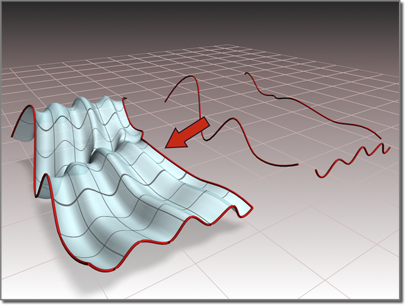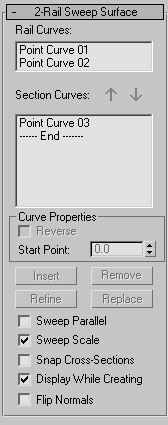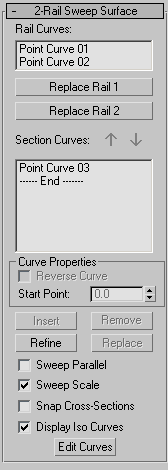![]()

Sweep surface created with two rails
The cross-section curves should intersect the rail curves. If the cross sections don't intersect the rails, the resulting surface is unpredictable. In addition, the initial points of the rails and the endpoints of the first cross-section curve must be coincident. Use NURBS Snaps to accomplish this.
Automatic Curve Attachment
When you create a 2-rail sweep, you can select curves that are not already sub-objects of the active NURBS model. You can select another curve or spline object in the scene. When you select that curve, it attaches to the current object as if you had used the Attach button.
As you move the mouse over a curve that is not part of the active NURBS object, the cursor changes shape to indicate that you can pick the curve, but the curve is not highlighted in blue.
Procedures
To create a 2-rail sweep:
- Create the curves that define the surface you want to create.
- In the NURBS toolbox, turn on
 (Create 2-Rail Sweep).
(Create 2-Rail Sweep). - Click the curve to use as the first rail, then click the curve to use as the second rail. Click each of the cross-section curves, and then right-click to end creation.
The sweep is interpolated smoothly between the cross sections, following the outlines defined by the two rails.
As you click curves, their names appear in the lists on the 2 Rail Sweep Surface creation rollout. The order in which you click the curves can affect the shape of the sweep surface.
Example: To create a 2-rail sweep with automatic attach:
- Go to the
 Create panel and create three independent CV or Point NURBS curves.
Create panel and create three independent CV or Point NURBS curves. - Go to the
 Modify panel. In the NURBS toolbox, click to turn on
Modify panel. In the NURBS toolbox, click to turn on  (Create 2-Rail Sweep).
(Create 2-Rail Sweep). - Click the curves in the appropriate order for the sweep.
3ds Max creates the sweep. You don't need to collapse the curves to a NURBS surface or Attach them to an existing NURBS model.
As you move the mouse over a curve that is not part of the active NURBS object, the cursor changes shape to indicate that you can pick the curve, but the curve is not highlighted in blue.
Interface
While a 2-rail sweep sub-object is selected, a rollout with the 2-rail sweep parameters appears. This rollout appears only and when one 2-rail sweep sub-object is selected. It isn’t possible to edit more than one 2-rail sweep at a time, so unlike some other NURBS sub-objects, the rollout doesn’t appear when multiple 2-rail sweep sub-objects are selected.
2-Rail Sweep Surface rollout (creation time)

- Rail Curves
-
Shows the names of the two curves you chose to be the rails.
- Section Curves
-
This list shows the names of the cross-section curves, in the order you click them. You can select a curve by clicking its name in the list. Viewports display the selected curve in blue.
- Arrow Buttons
-
Use these to change the order of section curves in the list. Select a curve in the list, and then use the arrows to move the selection up or down.
Curve Properties group
These controls affect individual curves you select in the Section Curves list, as opposed to properties of the sweep surface in general. They are enabled only when you have selected a curve in the Section Curves list.
- Reverse
-
When set, reverses the direction of the selected curve.
- Start Point
-
Adjusts the position of the curve's start point. This can help eliminate unwanted twists or "buckles" in the surface.
This control is disabled if the curve is not a closed curve.
While you're adjusting start points, a dotted blue line is displayed between them, to show the alignment. The surface is not displayed, so it doesn't slow down adjustment. When you release the mouse button, the surface reappears.
- Insert
-
(Disabled.)
- Remove
-
Removes a curve from the list. Select the curve in the list, and then click Remove.
- Refine
-
(Disabled.)
- Replace
-
(Disabled.)
- Sweep Parallel
-
When off, the rail curves define a ruled surface, and the cross sections describe lofting from this base ruled surface. When on, each cross section is associated with its best fitting plane. This plane moves along the rails and parallel to them. If the rails are curved, the plane can rotate. If the spacing between the rails changes, the section scales or stretches. In either case, the surface is blended from section to section along its entire length. Default=off.
- Sweep Scale
-
When off, the size of the plane is scaled only in the direction across the rails. When on, the plane is scaled uniformly in all directions. Default=off.
- Snap Cross-Sections
-
When on, cross-section curves are translated and scaled so they intersect both rails. The first cross section is translated to the start of the rails, and the last to the end of the rails. The cross sections in the middle are translated to touch the rails at the closest point to the ends of the cross-section curves. Default=off.
When Snap Cross-Sections is on, the sweep follows the rail curves exactly. This makes it easier to construct 2-rail sweep surfaces.
- Display While Creating
-
When on, the sweep surface is displayed while you create it. When off, the sweep can be created more quickly. Default=off.
- Flip Normals
-
Reverses the direction of the sweep's normals.
2-Rail Sweep Surface rollout (Modification time)

- Rail Curves
-
Shows the names of the two curves you chose to be the rails.
- Replace Rail 1 and Replace Rail 2
-
Let you replace the rail curves. Click one of these buttons, then in a viewport click the curve to use as the new rail.
- Section Curves
-
This list shows the names of the cross-section curves, in the order you click them. You can select a curve by clicking its name in the list. Viewports display the selected curve in blue.
- Arrow Buttons
-
Use these to change the order of section curves in the list. Select a curve in the list, and then use the arrows to move the selection up or down.
Curve Properties group
These controls affect individual curves you select in the Section Curves list, as opposed to properties of the sweep surface in general. They are enabled only when you have selected a curve in the Section Curves list.
- Reverse
-
When set, reverses the direction of the selected curve.
- Start Point
-
Adjusts the position of the curve's start point. This can help eliminate unwanted twists or "buckles" in the surface.
This control is disabled if the curve is not a closed curve.
While you're adjusting start points, a dotted blue line is displayed between them, to show the alignment. The surface is not displayed, so it doesn't slow down adjustment. When you release the mouse button, the surface reappears.
- Insert
-
Adds a curve to the section list. Click to turn on Insert, then click the curve. The curve is inserted before the selected curve. To insert a curve at the end, first highlight the "----End-----" marker in the list.
- Remove
-
Removes a curve from the list. Select the curve in the list, and then click Remove.
- Refine
-
Refines the 2-rail sweep surface. Click to turn on Refine, then click an iso curve on the surface. (As you drag the mouse over the surface, the available section curves are highlighted.) The curve you click is converted to a CV curve and inserted into the sweep and the section list. As when you refine a point curve, refining a sweep can change the curvature of the surface slightly. Once you’ve refined the surface by adding a cross-section curve, you can use Edit Curves to change the curve.
- Replace
-
Lets you replace the selected curve. Select a curve in the list, click this button, then select the new curve.
- Sweep Parallel
-
When off, the rail curves define a ruled surface, and the cross sections describe lofting from this base ruled surface. When on, each cross section is associated with its best fitting plane. This plane moves along the rails and parallel to them. If the rails are curved, the plane can rotate. If the spacing between the rails changes, the section scales or stretches. In either case, the surface is blended from section to section along its entire length. Default=off.
- Sweep Scale
-
When off, the size of the plane is scaled only in the direction across the rails. When on, the plane is scaled uniformly in all directions. Default=off.
- Snap Cross-Sections
-
When on, cross-section curves are translated and scaled so they intersect both rails. The first cross section is translated to the start of the rails, and the last to the end of the rails. The cross sections in the middle are translated to touch the rails at the closest point to the ends of the cross-section curves. Default=off.
When Snap Cross-Sections is on, the sweep follows the rail curves exactly. This makes it easier to construct 2-rail sweep surfaces.
- Display Iso Curves
-
When set, the 2-Rail Sweep's V-axis iso curves are displayed as well as the U-axis curves used to construct the sweep. The V-axis curves are only for display. You can’t use them for surface construction.
- Edit Curves
-
Lets you edit the currently selected curve without switching to another sub-object level. Click to turn on Edit Curve. The points or CVs of the curve are displayed, as well as the control lattice if the curve is a CV curve. You can now transform or otherwise change the points or CVs as if you were at the Point or Curve CV sub-object level. To finish editing the curve, click to turn off Edit Curves.
Tip: When you edit curves in a 2-rail sweep, turning off display of the sweep itself can make the curves easier to see and improve performance as well. Use +D (while the Keyboard Shortcut Override Toggle is on) to toggle display of dependent sub-objects, including sweeps.
+D (while the Keyboard Shortcut Override Toggle is on) to toggle display of dependent sub-objects, including sweeps. The sweep surface can deviate from the curve if you edit a curve in a sweep by increasing the weight of the curve CVs. You can work around this by refining the curve at the point where the surface deviates.